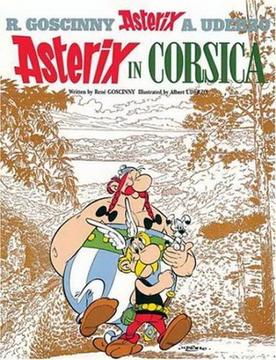
Asterix is a French comic album series about a village of indomitable Gaulish warriors who adventure around the world and fight the odds of the Roman Republic, with the aid of a magic potion, during the era of Julius Caesar, in an ahistorical telling of the time after the Gallic Wars.

Asterix the Gaul is the first volume of the Asterix comic strip series, by René Goscinny (stories) and Albert Uderzo (illustrations). In Le Monde's 100 Books of the Century, a 1999 poll conducted by the French retailer Fnac and the Paris newspaper Le Monde, Asterix the Gaul was listed as the 23rd greatest book of the 20th century.

Dogmatix is a fictional white terrier dog who is a companion to Obelix in the Asterix comics. Dogmatix is a pun on the words dog and dogmatic. In the original French, his name is Idéfix, itself a pun on the French expression idée fixe meaning an obsession.

Asterix and the Chieftain's Shield is the eleventh volume in the Asterix comic book series, written by René Goscinny and drawn by Albert Uderzo. It was originally published as a serial in Pilote issues 399–421 in 1967.

Asterix and the Black Gold is the twenty-sixth volume of Asterix comic book series, originally published in 1981. It is the second book to be both written and drawn by Albert Uderzo.

Asterix the Gladiator is the fourth volume of the Asterix comic book series, by René Goscinny (stories) and Albert Uderzo (illustrations). It was first serialized in the magazine Pilote, issues 126–168, in 1962.

Asterix and the Magic Carpet is the twenty-eighth volume of the Asterix comic book series by René Goscinny (stories) and Albert Uderzo (illustrations). It was first published in 1987, and was translated into English in 1988. It is the fourth Asterix album to be published after the death of René Goscinny in 1977 and is thus both written and drawn by Albert Uderzo alone.

Asterix the Legionary is the tenth Asterix book in the Asterix comic book series by Rene Goscinny and Albert Uderzo. It was first published as a serial in Pilote magazine, issues 368–389, in 1966.

Asterix and the Normans is the ninth book in the Asterix comic book series, written by René Goscinny and drawn by Albert Uderzo. It was first published in serial form in Pilote magazine, issues 340–361, in 1966. It depicts a meeting between Asterix's Gaulish village and a ship full of Normans (Vikings).

Asterix in Belgium is the twenty-fourth volume of the Asterix comic book series, by René Goscinny (story) and Albert Uderzo (illustrations).

Asterix and Caesar's Gift is the twenty-first volume of the Asterix comic book series, by René Goscinny (stories) and Albert Uderzo (illustrations). It was the first Asterix adventure that was not published in serial form in Pilote magazine prior to its publication as a book.

Asterix in Corsica is the twentieth volume of the Asterix comic book series, by René Goscinny (stories) and Albert Uderzo (artwork). It was originally serialized in Pilote issues 687–708 in 1973. It is the best-selling title in the history of the series, owing to its sales in the French market, but is one of the least-selling titles in the English language.

Asterix and the Soothsayer is the nineteenth volume of the Asterix comic book series, by René Goscinny (stories) and Albert Uderzo (illustrations). It was originally serialized in Pilote issues 652-673 in 1972.

Asterix and the Laurel Wreath is the eighteenth volume of the Asterix comic book series, by René Goscinny (stories) and Albert Uderzo (illustrations). It was originally serialized in the magazine Pilote, issues 621–642, in 1971 and translated into English in 1974.

The Mansions of the Gods is the seventeenth graphic novel of the Asterix comic book series, written by René Goscinny and illustrated by Albert Uderzo and released in 1971. Originally released as a serial for the magazine Pilote, it was later made into a graphic novel, with an English translation released in 1973. The story focuses on Asterix and the Gauls attempting to thwart the latest Roman plan against them, when Caesar decrees that the forest surrounding them be converted into a new Roman colony for the wealthy.

Asterix in Switzerland is the sixteenth volume of the Asterix comic book series, by René Goscinny (stories) and Albert Uderzo (illustrations). It was originally serialized in Pilote magazine issues 557–578 in 1970 and translated into English in 1973.

Asterix Conquers America is a 1994 German animated film, directed by Gerhard Hahn, and co-produced by Hahn and Jürgen Wohlrabe. The film is a loose adaptation of the Asterix graphic novel, Asterix and the Great Crossing, and the second film adaptation to be produced outside France. It is also the first Asterix movie to be made in English. The plot focuses on Asterix and Obelix seeking to rescue Getafix, who is transported to North America by the Romans, before their village runs out of magic potion to defend themselves.

Asterix: The Mansions of the Gods, also titled Asterix and Obelix: Mansion of the Gods, is a 2014 French animated adventure family comedy film directed by Louis Clichy with a story written and co-directed by Alexandre Astier.The film features the voices of Roger Carel, Guillaume Briat, Lionnel Astier, Serge Papagalli, and Florence Foresti. The film was Carel's last film before his retirement and later death. It was the first Asterix film animated in 3D.

Asterix & Obelix: The Middle Kingdom is a 2023 French live-action adventure comedy film directed and co-written by Guillaume Canet, who also stars as Asterix. It is the fifth installment in the Asterix live-action film series.



















